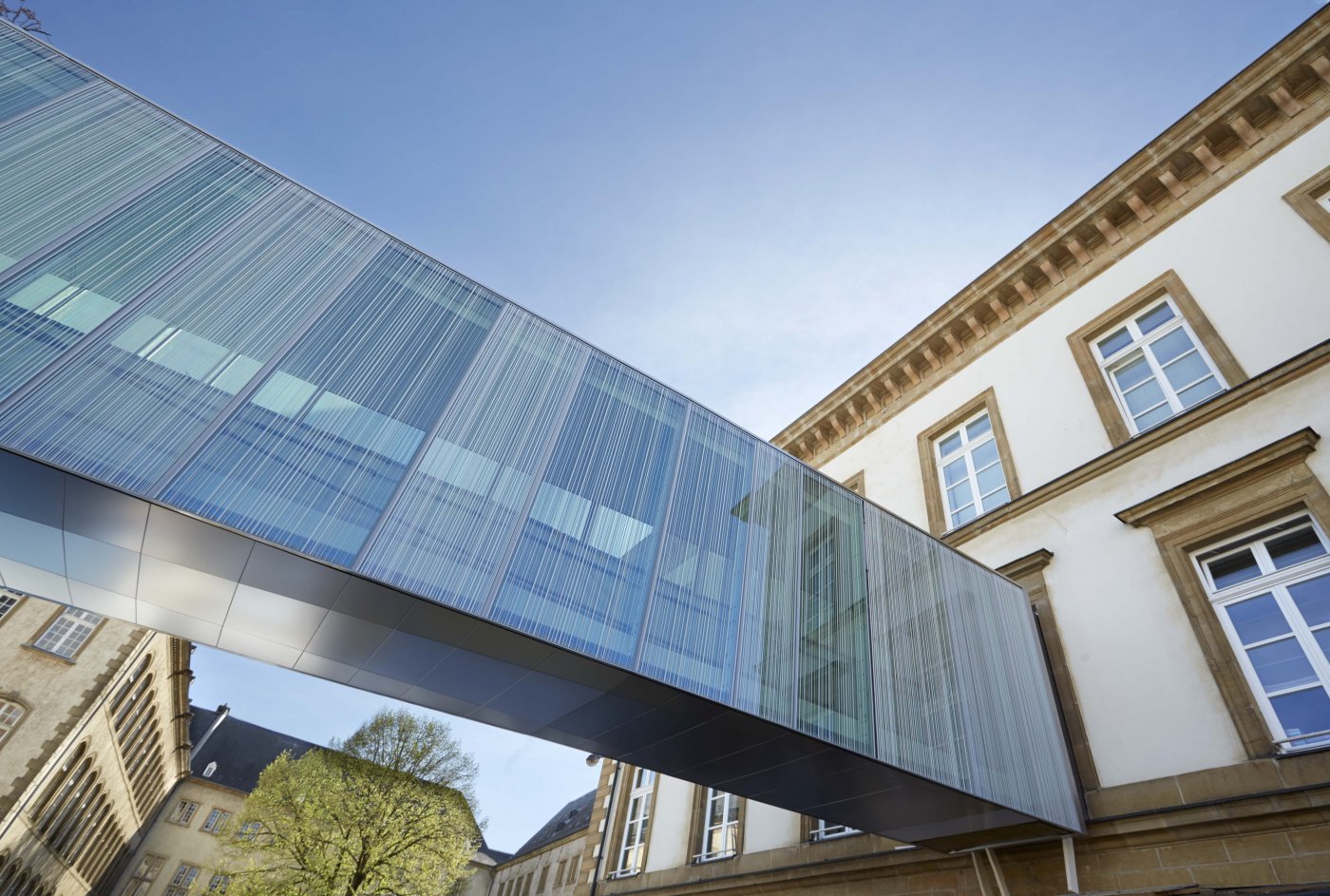Summary record
Video
Watch the video recording of this session.
Homework support in foyers scolaires and "e-Bichelchen"
QUESTION POSED BY ANA CORREIA DA VEIGA
As of the 2022–2023 school year, the foyers scolaires (childcare centres) have been organising homework support for children in Cycles 2–4 of elementary school. The "e-Bichelchen" app was introduced to facilitate communication between the foyers scolaires and parents.
It appears that not everything is going as planned. For example, some foyers scolaires apparently do not have access to "e-Bichelchen" because the City of Luxembourg's operating system is not compatible. Hence my questions today. And I also want to use this opportunity to ask the College of Aldermen to provide an update on this issue.
How many children are signed up for homework support in the foyers scolaires?
What are the times that have been scheduled for homework support? Do these times conflict with other activities planned at the foyers scolaires?
How many children actually show up to receive homework support?
Do the foyers scolaires have a general concept and/or concepts that are tailored to individual foyers scolaires to organise homework support as effectively as possible?
What qualifications do the staff members in charge of homework support have?
Can the College of Aldermen confirm that the operating system enabling access "e-Bichelchen" did in fact break down? Was this situation resolved?
Do the children have access to "e-Bichelchen", and has this new tool made them less independent?
RESPONSE PROVIDED BY ALDERWOMAN COLETTE MART
The Ministry of Education, Children and Youth (Ministère de l'Éducation nationale, de l'Enfance et de la Jeunesse – MENEJ) had tasked the foyers scolaires with introducing homework support in the 2022–2023 school year. As a result, the City was no longer entitled to organise the "guided study" sessions. However, this was not a new duty for the foyers scolaires: homework assistance has always been offered. Our policies and procedures regarding the foyers scolaires provide detailed information on how this operated in the past: the children had a quiet place to work, a "Hausaufgabebichelchen" (homework report book) was used to communicate on homework, and childcare workers were in contact with parents and teachers.
Homework support is currently offered to pupils in Cycles 2–4, on Tuesdays and Thursdays from 14:00 to 15:00 (1,685 children registered), and on Mondays and Wednesdays at 16:00 (1,487 children registered). Staff members check that all of the children are doing their homework. Each foyer scolaire decides how to organise things. Nevertheless, we can assure parents that their children are doing their homework. Currently, the City meets all MENEJ requirements regarding staff qualifications. Of the 264 childcare workers employed by the Service Foyers (Childcare Department), 251 have completed the "e-Bichelchen" training offered by the Institut de formation de l'Éducation nationale (IFEN).
We are unable to confirm whether there was a breakdown in access to "e-Bichelchen".
Our goal is to have children do their homework, and we have taken steps to ensure that they do so. Whether the "Bichelchen" that is used is in paper or electronic format is not necessarily our priority. However, each child has access to "e-Bichelchen".
The City plans to continue to develop its IT capabilities. The foyers scolaires will need to develop overarching specifications that address, among other things, providing the foyers scolaires with tablet computers, which will increasingly supplant paper.
The Service Technolink (Technolink Department), in consultation with the Service TIC (ITC Department) and the Service Foyers scolaires, will ensure that the foyers scolaires have access to the Technolink Network.
Pedestrian safety near the Belair-Kayser school at the beginning and end of the school day
QUESTION POSED BY GUY FOETZ
The guide on traffic calming within urban areas, issued by the National Traffic Committee (Commission de la circulation de l'État), which the City of Luxembourg sits on, contains the following recommendation for municipalities: "It is recommended that municipalities implement a Séchere Schoulwee concept as part of the creation of a 30 km/h zone in order to make dangerous spots on routes to schools safe".
On 11 May 2023, the alderman in charge of mobility presented to the press a review of urban mobility in Luxembourg City and an overview of projects for the future, especially with regard to measures that prioritise pedestrians and traffic calming through the introduction of 30 km/h zones.
Schoolchildren are among the most vulnerable road users. Busy vehicular traffic presents risks in front of many schools in Luxembourg City. For example, it was reported to me that the school committee and the parent representatives of the Belair-Kayser school (Aloyse Kayser) had informed the College of Aldermen of the dangerous traffic in front of the Belair-Kayser school at the beginning and end of the school day.
How does the College of Aldermen plan to respond to the request to improve safety at the intersection of Rue Aloyse Kayser and Rue des Arquebusiers opposite the school by installing one or several pedestrian crossings, which may be raised to make it easier for pedestrians to be seen?
The National Traffic Committee's guide on traffic calming in urban areas expressly stipulates that pedestrian crossings should be created in 30 km/h zones on routes to schools or school bus stops. As I recall, the City's departments told the Safety Officer at the Belair-Kayser school that a 30 km/h zone would not require the creation of pedestrian crossings. Can the College of Aldermen confirm or refute that this is the City's policy when it comes to creating 30 km/h zones near schools?
This same National Traffic Committee guide specifies that there must always be a pedestrian crossing with a red background on entering a 30 km/h zone from a national road where the speed limit is 50 km/h or higher. Doesn't the College of Aldermen think that this rule should also apply on entering 30 km/h zones from municipal roads – as is the case for Rue d'Ostende – in order to ensure the safety of our most vulnerable road users?
Pending the creation of one or more pedestrian crossings, does the College of Aldermen believe it is crucial to station a municipal worker in front of the Belair-Kayser school at the intersection of Rue Aloyse Kayser and Rue des Arquebusiers to help children cross, as the school committee and parent representatives have requested?
RESPONSE PROVIDED BY ALDERMAN PATRICK GOLDSCHMIDT
We must bear in mind that the Aloyse Kayser school is located in a 30 km/h zone without drive-through traffic, near a place where the road ends in a dead end. In accordance with the government's recommendations, the City does not create pedestrian crossings in 30 km/h zones. There are exceptions to this rule, but only on streets with a lot of traffic, and in places where it is hard to determine the best route for children. The moderate traffic zone in the vicinity of the Aloyse Kayser school has the advantage that the children can cross the street anywhere. If we created a pedestrian crossing, the children would not be able to cross the street less than 30 metres away from it.
During an on-site meeting on 30 November 2022 with the school monitoring committee – which is made up of representatives of the Traffic Police, the Police Road Safety Awareness Department and the City of Luxembourg's Service Enseignement (Education Department), Service Circulation (Traffic Department) and Service Parking (Parking Department) – it was noted that the only dangerous situations in the vicinity of the Aloyse Kayser school are caused by the parents who stop in places where they are not supposed to.
The configuration of the site would allow either creating a pedestrian crossing at the end of the dead end – which would eliminate several parking spaces without improving safety – or creating a pedestrian crossing in a location that is contrary to the government's recommendations.
Councillor Foetz proposed creating a pedestrian crossing with a red background, recalling that the National Traffic Committee guide specifies that there must always be a pedestrian crossing with a red background on entering a 30 km/h zone from a national road where the speed limit is 50 km/h or higher. However, because Rue d'Ostende is not a national road, Councillor Foetz answered his own question.
Nevertheless, I suggest that the relevant City departments return to the site to revive discussions with the school committee and parent representatives to see if it would be possible to make improvements in the interest of the children's safety. This could include, if required, the elimination of a parking space or two.
Regarding stationing a municipal worker at the site to help children cross the street, in accordance with discussions held with the school stakeholders, there is a worker stationed on Route d'Arlon, the four-lane main entry and exit artery of the city, which sees significant traffic.
We will examine the possibility of organising a Pedibus to encourage parents not to drive their children to school. We will present our findings to the parents to see if additional improvements can be made.
Bike cleaning stations
QUESTION POSED BY CLAUDINE KONSBRUCK
The City actively supports developing the use of bikes in Luxembourg City. As such, I would be interested to know if the City plans to set up a bike cleaning and maintenance station, as other municipalities – such as Hesperange and Mamer – have done. This could make life easier for a lot of users.
RESPONSE PROVIDED BY ALDERMAN PATRICK GOLDSCHMIDT
There are no plans to install a bike cleaning station in Luxembourg City. Other circumstances led to the creation of the cleaning station in Hesperange – namely, that people bike in the forest for recreation. In the city, bikes are used mainly to get from point A to point B, and particularly to get to work. The cleaning station in Hesperange is also located in a place that is not comparable to a spot in the urban space – such as the Kinnekswiss, to name but one – where there would be the risk that people would use a bike cleaning station improperly, such as to fool around and get into water fights.
Modifications for people with reduced mobility (access for all)
QUESTION POSED BY CHRISTA BRÖMMEL
In 2022, the City of Luxembourg won the Access City Award for its accomplishments in access for all.
I have a two-pronged question about the modification of bus stops and about traffic islands. More specifically, I want to ask about problematic situations in two places in Kirchberg, which probably falls under the purview of the Fonds Kirchberg.
How many bus stops in the city have already been elevated in compliance with the "Kasseler Bord" standard? What criteria guided decisions on whether to elevate a bus stop platform?
How many pedestrian crossings still need to be upgraded so that people in wheelchairs can cross the street without running into kerbs and traffic islands that have not been lowered?
Why is the "Rehanzenter" stop on Rue André Vésale still not equipped with an elevated platform?
Does the College of Aldermen plan to approach the Fonds Kirchberg to upgrade the bus stops on Rue André Vésale and the pedestrian crossing at the exit of the LuxExpo north car park?
Is there a plan to make this upgrade at all bus stops and pedestrian crossings in the city? When would that be completed?
RESPONSE PROVIDED BY ALDERMAN PATRICK GOLDSCHMIDT
I can assure Councillor Brömmel that our departments do have a plan.
I myself often use public transport, and I make a point of talking to users with reduced mobility, who tell me about the problems they encounter.
We are currently taking inventory of the bus stops' technical features (height of the kerb, modifications for people with reduced mobility, etc.).
There are approximately 1,000 bus stops in Luxembourg City. Wherever possible, "Kasseler Bord" configurations are implemented as needed as development work is carried out. If needed, the bus stop in question is moved so that the desired modifications can be made.
Practically all bus lines have stops at locations that are challenging for people with reduced mobility or with pushchairs – for example, because they are near garage exits. This is why all municipal buses have a retractable ramp, and all of our drivers are trained to be attentive to the needs of people with reduced mobility and to help them get off the bus if needed.
The Access City Award recognises all of the work accomplished by the municipal departments over the past years. We are aware that we cannot rest on our laurels and that we must continue our efforts when it comes to access for all.
If users with reduced mobility report any problems to the Service Autobus (Bus Department) or Service Intégration et Besoins spécifiques (Integration and Special Needs Department), the City will make sure to find a solution as soon as possible.
The stop near the Rehazenter existed before the Rehazenter was built. The plan was to modify the bus stops as part of the construction of housing in this area. However, we agree with you that this bus stop needs to be upgraded as soon as possible, and the City will contact the FUAK about this.
Regarding the traffic islands that have not been lowered in the middle of pedestrian crossings, the relevant municipal department will be notified about the problems that people with reduced mobility are encountering, and will ensure that this situation is remedied.
Planned cycle bridge between Bisserwee and Rue Saint Ulric
QUESTION POSED BY TOM KRIEPS
I read in the papers that there are plans to build a cycle bridge between Bisserwee and Rue Saint Ulrich. This idea is commendable because it would make life easier for cyclists, who will be able to travel towards Hesperange without crossing the Rue Munster bridge. However, it seems to me that this project has not yet been discussed by the Municipal Council. Could the College of Aldermen provide us with additional information on this topic?
RESPONSE PROVIDED BY ALDERMAN PATRICK GOLDSCHMIDT
This cycle bridge has not been discussed by the Municipal Council because the project costs – €305,000 for the bridge itself, plus fees, etc. – are below the threshold above which a project is required to be submitted to the Municipal Council for approval. In addition, we were sure that the Municipal Council would approve this project unanimously, given how important it is for pedestrians and cyclists.
Parking ticket machines
QUESTION POSED BY TOM KRIEPS
My question is about the parking ticket machines in Luxembourg City. The parking ticket that I attached to my written question shows the poor printing quality of some machines. Moreover, many machines do not allow people to pay for tickets by mobile phone or credit card. Does the City anticipate replacing the obsolete machines? The city of Dudelange, for example, has introduced a mobile-phone payment system, although it did not adequately publicise it, especially to people who do not live in Dudelange. While I am discussing this topic, I do want to applaud the fact that there are so many parking meters in Luxembourg City.
RESPONSE PROVIDED BY ALDERMAN PATRICK GOLDSCHMIDT
There are currently 1,394 parking meters in Luxembourg City. Of those, 483 are in the city centre and are fitted with credit card readers. The other 800-plus machines had the Mini-Cash system – which was done away with – but because so much money had been spent on the machines, the City wanted to keep them. The Call-to-Park system was introduced in some places but not everywhere.
Regarding the illegible parking ticket that you sent us with your question, what I can tell you is that our workers inspect the parking meters once a week to check whether the tickets are printed properly. In this specific case, a part was broken, and it has since been repaired.
To provide a modern solution that implements the technology available in 2023, the City will be introducing the "Indigo Neo" system on 1 June 2023. All of the parking zones in Luxembourg City have been mapped. With this system, all users – both residents and non-residents – will be able to download an app that they can use to pay for parking with their mobile phones. Thanks to the geolocation system, users who have entered their license plate number will see exactly where their car is located, and they can decide whether to pay the ticket. It goes without saying that we will need to publicise the existence of this system, not only when it is launched but also on an ongoing basis so that new residents and tourists are also aware of it. The system will be more convenient for users, and it has the advantage of allowing users to pay exactly for the actual parking time. Unlike the Call-to-Park system, users will not be required to pay a 50-cent communication fee at the beginning and end of the parking period. At first, this system will cover on-street parking spaces and the Neipperg car park. If it is compatible, it will also be rolled out to the other car parks.













![Image of event Tu ne tueras point [Dekalog : Cinq, version longue] (Kieslowski’s Dekalog)](https://storage.googleapis.com/lu-echo-prod-experiences/wNqoZmove5SG6TRjbN97Kc/tu-ne-tueras-point-dekalog-cinq-version-longue-kieslowski-s-dekalog-GsjW7U/media_DEKALOG5_main.jpg)

